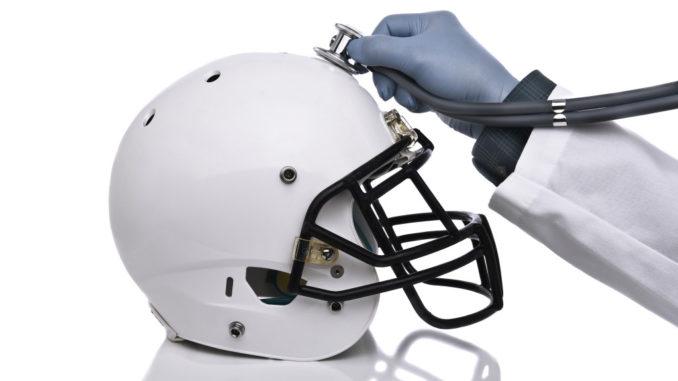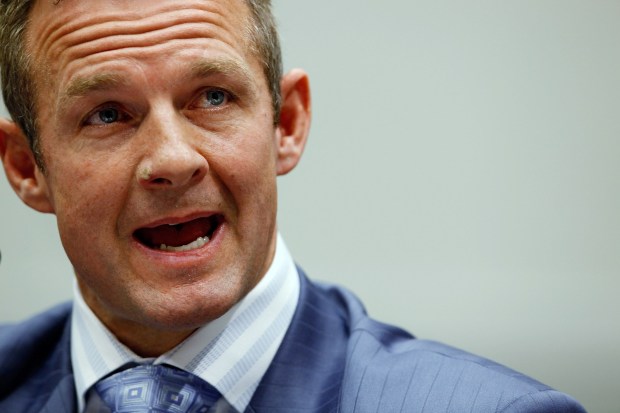
ATLANTA — The cultural needle, wielded by Saturday Night Live, pointed squarely at football last March.
The bit was an interview with sporting champions. Charles Barkley and Alex Rodriguez were joined by cast member Kenan Thompson, playing D.C. Timmons, “the hardest-hitting man in football” as a Pittsburgh linebacker.
Barkley and Rodriguez were suave and funny. Timmons was a one-car pileup. He kept calling his fellow guests “Greg.” He talked about how tough football was and said, “If you want to run with the big dogs, stay out of the kitchen.”
He ridiculed the unmarked face of “pretty boy” Rodriguez and said, “See these teeth? All of them are fake. And this eye is made of sugar … But it was all worth it for these four championship rings, baby.”
He held up three ringless fingers.
The host described Barkley’s 16 years of playing and A-Rod’s 22. Timmons? He played seven games.
“Spread out over nine years,” Timmons said. “But there was a death in the family.”
“I’m so sorry,” the host said.
“That’s OK,” Timmons said. “I was only dead for a little while.”
It was uproarious, for a little while.
Then you realized that SNL was just turning the mirror on society.
Football is no longer about the homecoming queen and the campus cachet and the letter sweater. It is now connected with injury and risk. Its players are known as victims, or dupes. Parents quarantine their children from it as surely as if it were whooping cough.
Junior varsity and freshman teams get consolidated for lack of numbers, even at the most fervent high schools. Few kids take up the game for fun. It is a means to an end.
The risk is real. Chronic traumatic encephalopathy (CTE) has become an established acronym, a doomsday buzzword. The Boston University CTE Center received 202 brains from deceased players and found CTE in 177 of them, including 110 out of 111 for NFL players and seven out of eight for CFL players.
The doctors acknowledged there was selection bias, because families only sent the brains of players suspected of harboring CTE. They said genetic factors and substance abuse could have prompted CTE as surely as football did. And the real breakthrough will only come when players can have their CTE measured while they’re still alive. At that point the decisions to play or not play will get easier.
The wave of concussion lawsuits has led to insurance difficulties. Pop Warner football is down to one insurance carrier. In Arizona, four of Maricopa County’s community colleges dropped football because insurance costs had ballooned. Ex-Ohio State quarterback Joe Germaine and USC offensive lineman Deuce Lutui came from those colleges.
Merril Hoge was an NFL running back for eight years. Most were spent with the Steelers, the first NFL team to provide baseline testing, in the form of written questions, for concussion victims.
When Hoge went to the Bears, he suffered a concussion but was cleared to play without precaution. He then sued the Bears for malpractice and became the first NFL player to win such a lawsuit.
His book “Brainwashed” is a lashing attack against what Hoge calls “junk science.” He says the link between football and CTE has not been fully established, and the movement to ban youth tackle football ignores new safety measures, and that correlation doesn’t equal causation.

Actually Hoge doesn’t say it alone. He collaborates with Dr. Peter Cummings, a neuropathologist at Boston University who allowed his 11-year-old son to play tackle football and has questioned the findings of the school’s CTE center.
“All we can say is that CTE is a pattern,” Cummings said in an interview for a neuropathology blog. “We don’t know what causes it and we don’t know what it causes.”
Cummings suggests that inflammation, after an episode of head trauma, could cause CTE, as could opioid abuse, alcohol abuse or obesity. Hoge points to a sizeable number of NFL players in their 70s who show no signs of dementia or brain damage, which doesn’t prove that football isn’t dangerous but may indicate that it isn’t automatically debilitating.
“The public should know that there exists cases where neuropathologists have looked at brains prior to the CTE Center and failed to find CTE, but when the brains arrive … they all have CTE,” Cummings said. “This diagnostic discrepancy is alarming.”
Todd Ewen, the former enforcer for the Anaheim Ducks who took his own life at age 49 in 2015, has become a posthumous lightning rod. Toronto doctors found no CTE in his brain, but the BU doctors did. It turned out that one of the Toronto doctors was an expert witness testifying for the NHL in concussion cases. Still, that has little to do with what Hoge and Cunnings call the “plot to destroy football.”
The alarms might not be pitch-perfect. But they have had an effect. There were 178 targeting calls in college football’s top division in both 2018 and 2017, which means 178 players were ejected. In the NFL there were 17 penalties for lowering the head to initiate contact, a rule that was largely ridiculed and labeled as unenforceable. The players adjusted, as they always do.
The game is not safe. It is safer.
In the NFC Championship game, Nickell Robey-Coleman of the Rams was not whistled for pass interference on the Saints’ Tommylee Lewis. The furor rages on, with New Orleans car dealer Matt Bowers buying billboards throughout Atlanta that say such things as “Cheated, Not Defeated.”
But several commentators noted that Robey-Coleman could have been flagged for helmet-to-helmet contact on Lewis. That is an illustration of awareness.
Michael Juels’ boys play football. He is the head of Gamebreaker, which has developed a soft-shell helmet that received the highest safety rating from the Virginia Tech researchers and is now a staple of flag and youth leagues throughout the nation. The CIF Southern Section is a client, as are Texas, Arizona State, Texas A&M and a dozen other FBS programs. It is another example of scientific rescue.
Juels’ headgear is also used in eight other sports, including rugby and soccer. College women’s soccer has a higher concussion rate than football. U.S. Soccer banned heading for players 10 years old and younger in 2015. But you can find neuropathy experts who say heading isn’t really the problem.
This would not be a controversy if football wasn’t worth saving, like cockfighting. But it is. As Hoge says, it is the ultimate team sport, a community in which the ego-tripper cannot survive. Even quarterbacks must learn to play with others.
A football program, on any level, spawns concentric relationships, from the players to the coaches to the families. There is pain and sacrifice and, yes, injury and sometimes worse. In 2017 there were 13 deaths in all levels of the game, according to the National Center for Catastrophic Sport Injury Research. Three were attributed to brain injury. Eight were attributed to heatstroke or cardiac arrest, tragedies that can be traced to overzealous coaches and skimpy medical attention, not the nature of football itself.
On Sunday, 106 men of various shape, size and agility will play in front of the largest TV audience of the year, and maybe of all-time. Super Sunday has become a secular holiday. Some of its fans have become severely fatigued over the sight of Tom Brady. Nevertheless, he remains more of a metaphor for football than D.C. Timmons.




